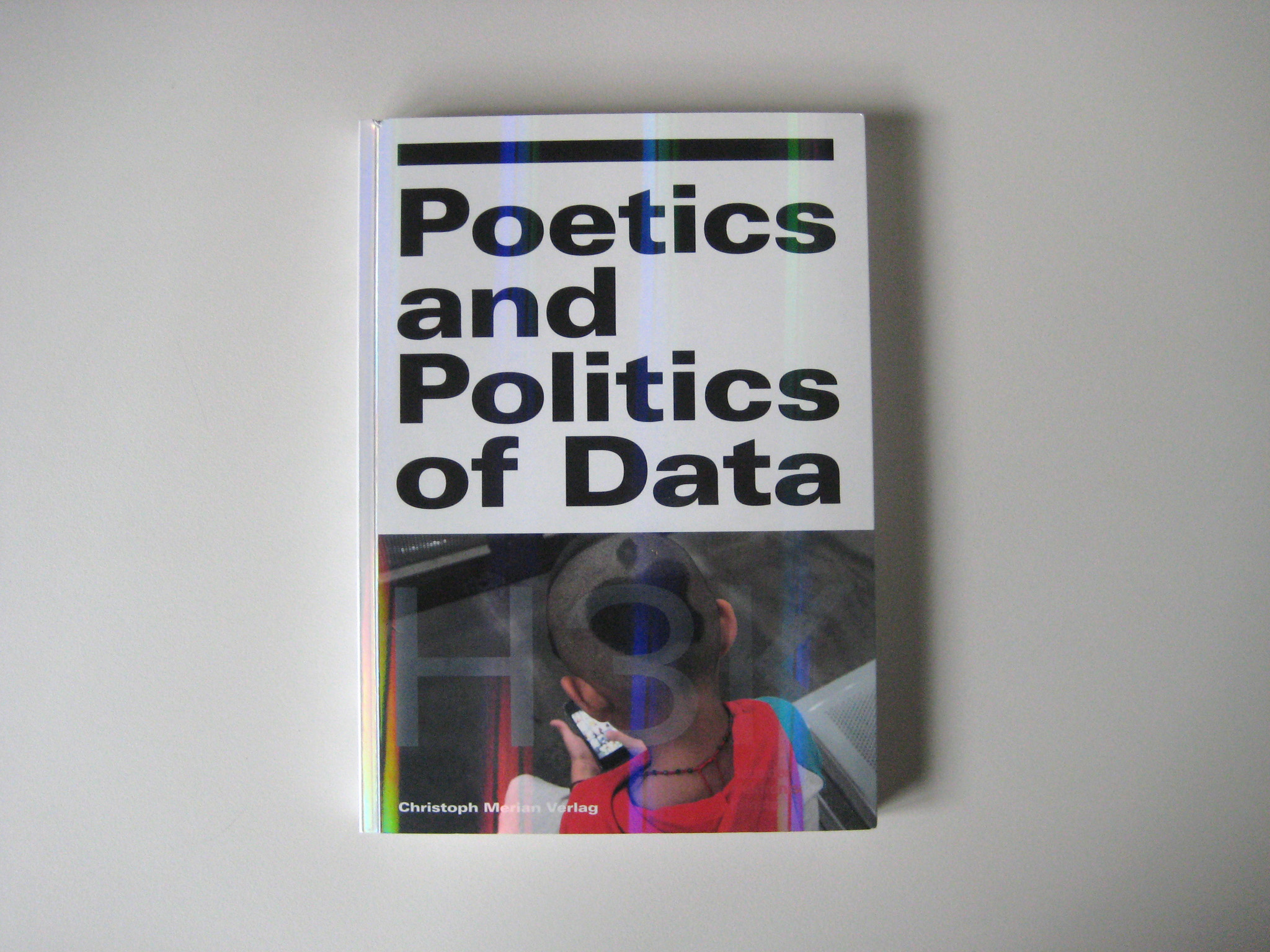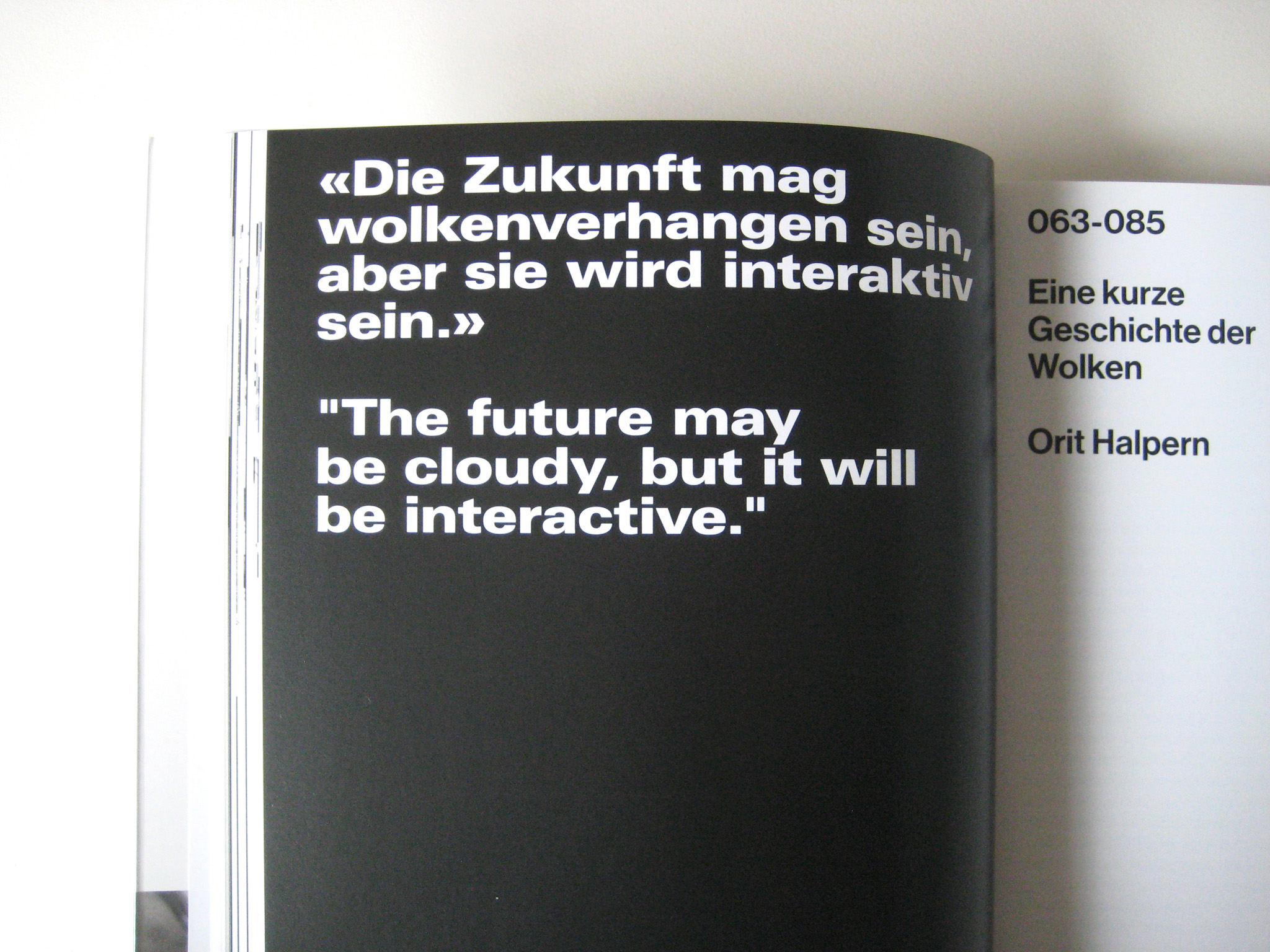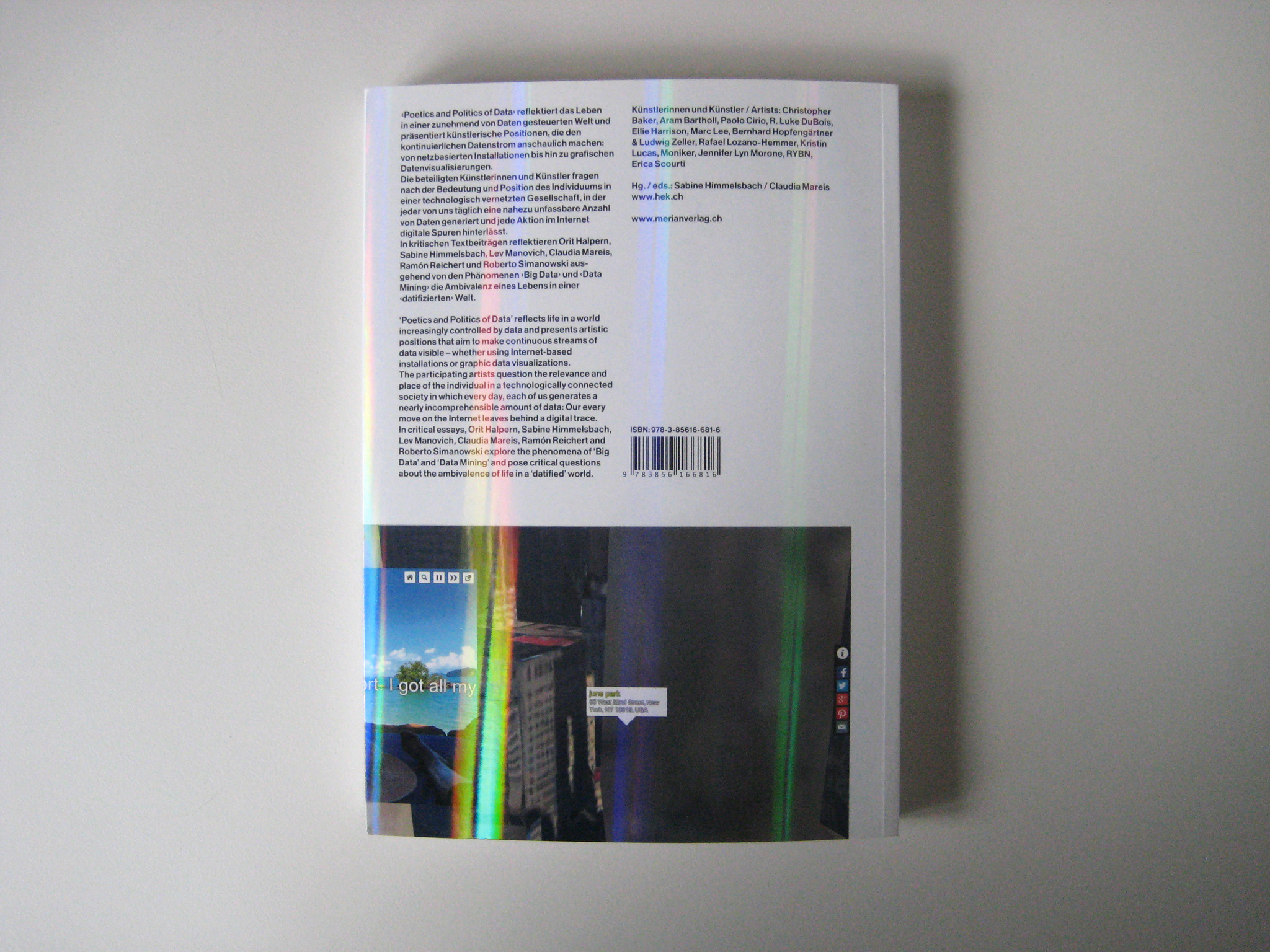Sticky Postings
All 242 fabric | rblg updated tags | #fabric|ch #wandering #reading
By fabric | ch
-----
As we continue to lack a decent search engine on this blog and as we don't use a "tag cloud" ... This post could help navigate through the updated content on | rblg (as of 09.2023), via all its tags!
FIND BELOW ALL THE TAGS THAT CAN BE USED TO NAVIGATE IN THE CONTENTS OF | RBLG BLOG:
(to be seen just below if you're navigating on the blog's html pages or here for rss readers)
--
Note that we had to hit the "pause" button on our reblogging activities a while ago (mainly because we ran out of time, but also because we received complaints from a major image stock company about some images that were displayed on | rblg, an activity that we felt was still "fair use" - we've never made any money or advertised on this site).
Nevertheless, we continue to publish from time to time information on the activities of fabric | ch, or content directly related to its work (documentation).
Monday, September 28. 2015
Poetics and Politics of Data (ed. S. Himmelsbach), HEK (Basel, 2015) | #data #clouds #society
Note: a book as a follow up of the exhibition for which fabric | ch designed the scenography last May at the Haus der elektronische Künste in Basel (project White Oblique, downloadable pdf on our website). I was implicated in a double way in the exhibition due to the fact that the content of the design research I'm jointly leading with Nicolas Nova for ECAL and HEAD, Inhabiting and Interfacing the Cloud(s), was also exhibited. I have the pleasure to publish a text in the book about the state and objectives of the ongoing research as well.
Via iiclouds.org
-----
Note: we’re pleased to see that the publication related to the exhibition and symposium Poetics & Politics of Data, curated by Sabine Himmelsbach at the H3K in Basel, has been released later this summer. The publication, with the same title as the exhibition, was first distributed in the context of the conference Data Traces. Big Data in the Context of Culture and Society that also took place at H3K on the 3rd andf 4th of July.
The book contains texts by Nicolas Nova (Me, My cloud and I) and myself (Inhabiting and Interfacing the Cloud(s). An ongoing Design Research), but also and mainly contributions by speakers of the conference (which include the american theorician Lev Manovitch, curator Sabine Himmelsbach and Prof. researcher from HGK Basel Claudia Mareis) and exhibiting artists (Moniker, Aram Bartholl, Rafael Lozano-Hemmer, Jennifer Lyn Morone, etc.)
The publication serves both as the catalogue of the exhibition and the conference proceedings. Due to its close relation to our subject of research (the book speaks about data, we’re interested in the infrastructure –both physical and digital– that host them), we’re integrating the book to our list of relevant book. The article A short history of Clouds, by Orit Halpern is obviously of direct signifiance to our work.
It can be ordered directly from H3K website:
Poetics and Politics of Data, 265 pp, ed. Christoph Merian Verlag, Basel, 2015 (29.- chf)
Friday, April 26. 2013
Resonate Festival
Via DomusWeb
-----
By Roberto Arista
With its second edition, the Serbian festival – a meeting point for technology and art – establishes itself as a sounding board for a mature and growing scene.

Resonate Festival, Belgrade, 2013. Projection during the debate with Memo Akten, Rainer Kohlberger, Eno Henze and Shane Walter.
Resonate was founded in 2012 by Magnetic Field B and the Creative Applications network, in an attempt to provide the visual arts world with a new platform for discussion. The event focuses on the role of technology in art and culture, and especially on the connections between the disciplines that these areas involve. The 2013 edition took place from March 21 to 23 in the Dom Omladine cultural space, close to the city’s Republic Square. More than 1200 visitors attended the event, which was already sold out several days before the opening.
The first day was devoted to a rich and varied assortment of workshops – open to all selected participants – regarding the analysis of the available tools (hardware and software) for video mapping, data visualization on different media, the design of cross-platform applications, or even the choreography of (flying) drones.
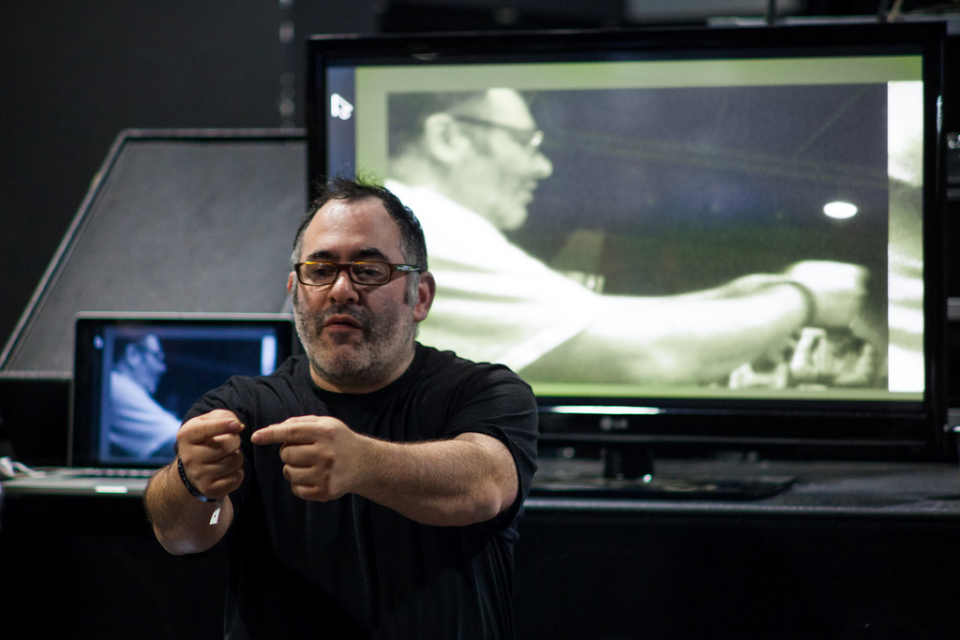
Golan Levin during the “Computer vision in interactive arts” workshop. Photo courtesy of Resonate
The next two days were dedicated to a full program of 44 lectures and video projections. The general impression is that there is a panorama of versatile designers who can carefully hybridise different disciplines and tools – marrying electronic engineering with products, landscape with graphics, analogical techniques with digital media. These designers are bolstered by the freedom to experiment that distinguishes those who are not pigeonholed within a specific category. The profession’s evolution and, more generally, a look at the recent past, were leitmotifs of some of the most interesting projects presented. Examples range from Memo Akten, Golan Levin and Joachim Sauter, who are now ready to offer an engaging retrospective of their projects, to the much admired by the public Meet your creator, Free Universal Construction Kit and Kinetic Sculpture.
The audience in the main room at Dom Omladine during the festival. Photo courtesy of Resonate
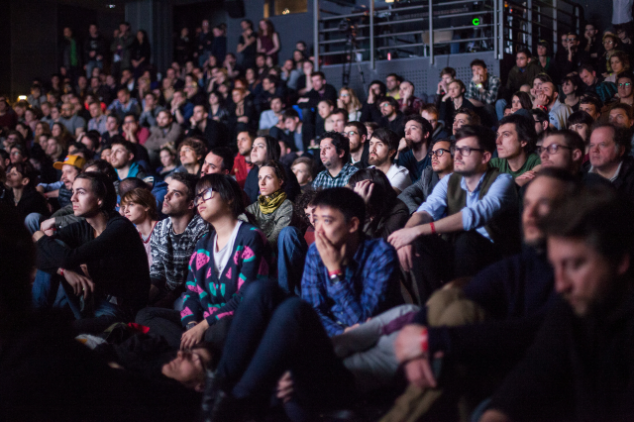
Similarly, a lively debate followed the talk by artist and interaction designer Zach Gage. Is it possible that the "game" – understood within a broader realm than the videogame – has not yet found the right place to be preserved, celebrated and narrated?

A view of the Building Kluz, where many of the festival's performances took place. Photo courtesy of Resonate
Participants were moved by London-based architect, critic and curator Liam Young’s future scenarios and landscape mutations. Projects like Silent Spring dampened that blind faith in technological advancement that permeated the festival. The work by professors in Europe’s most popular Interaction Design courses was of great interest, in particular Anthony Dunne from the RCA in London, David Gauthier from CIID in Copenhagen and Alain Bellet from ECAL in Lausanne. These schools have overcome the unnecessary separation between the humanistic and scientific universes, while in Italy the legacy left behind by Benedetto Croce still paralyses many university courses.
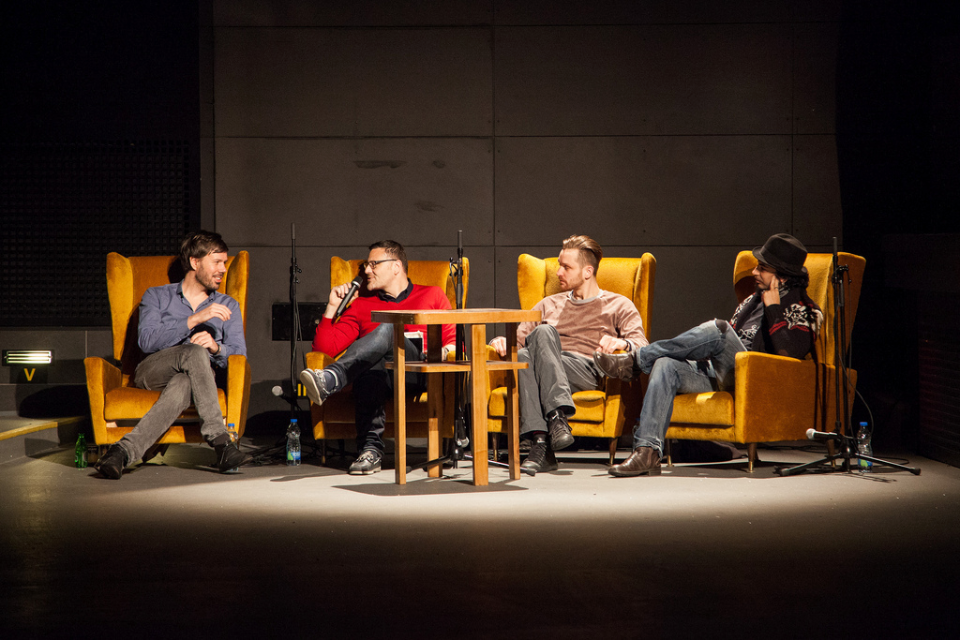
Debate participants during the second day of the festival: Memo Akten, Rainer Kohlberger, Eno Henze and Shane Walter. Photo courtesy of Resonate
It is striking that there were no Italian presenters given the number of European speakers. This is probably due to the Italian design world’s reluctance to accept the digital sphere. However, some undisputed masters were mentioned: Luigi Serafini, whose Codex Seraphinianus has become an international case study, or Bruno Munari’s work in design teaching.
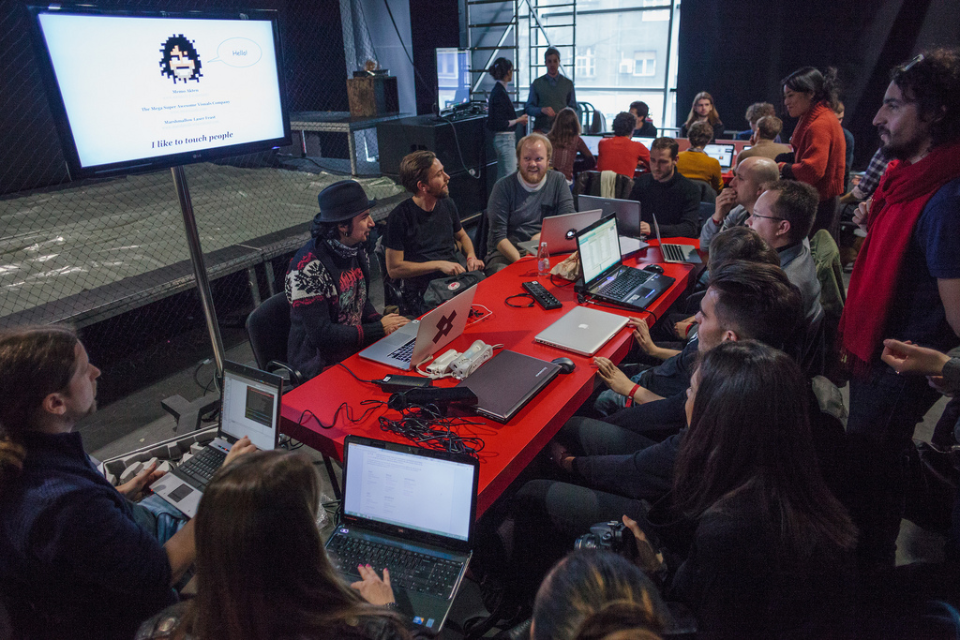
A view of Memo Atken's "How I learnt to stop worrying and love the drones" workshop. Photo courtesy of Resonate.
It became evident that childlike curiosity is fundamental in developing languages and tools. Many festival speakers dared to compare their more mature projects with images from their childhoods, so it is no coincidence that a statement by Carl Sagan’s was heard several times during the festival: "Every kid starts out as a natural-born scientist, and then we beat it out of them. A few trickle through the system with their wonder and enthusiasm for science intact." Roberto Arista
Related Links:
Personal comment:
A little report by Roberto Arista on Domusweb about the last and good Resonate conference that happened in Belgrade last March. With the talk of Alain Bellet that is head of the very good bachelor in Interaction Design at the ECAL, in Lausanne Switzerland (and occasionally, my "boss" too, as I'm teaching there as well)!
Friday, May 28. 2010
Les Editions Volumiques, Paper computing and curious reading interactions
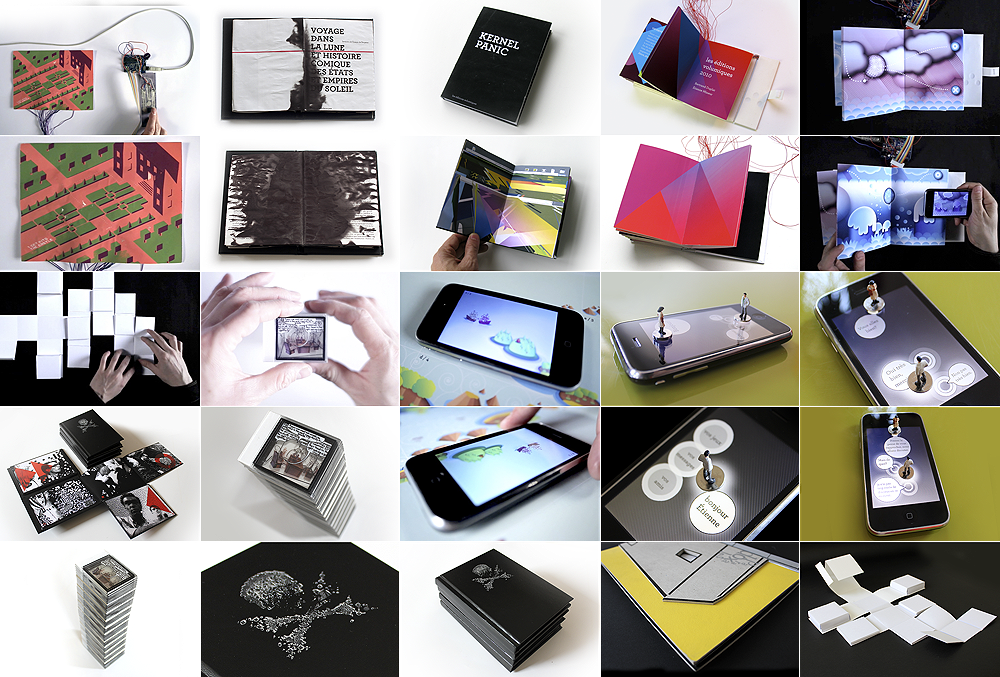
Les Editions Volumiques finally launched their website showing plenty of curious and original products based on mixing paper and digital technologies:
“Here are the first pieces of les évolutions dynamiques following research on both volume and interactivity, playfully mixing paper and computation. By allowing interactivity and gameplay in the page (for example with the Duckette project) or between the pages (in The book that turns its own pages, or Labyrinthe), we try to bring new life to paper. We then pushed physical behavior to paper and ink (the book that disapears). There, the paper is no longer only the frame for representation, but at the same time the field of a real physical experience. We also played with the volume and perspective of book and content (paradoxales, Meeting-Zombies). And then, we tried to combine paper with this little computer-object almost of us all carry everywhere: our cell phone (the night of the living dead pixels, (i) pirates).“
Why do I blog this? I find these projects fascinating and love the idea of mixing digital tech with paper to create compelling user experiences. The examples showed on the picture (see more on their website) are stunning and show the future of books go far beyond boring reading machines. The use of playful metaphors and game mechanics in the work of Bertrand and Etienne are also highly intriguing for those interested in inspiring ways to renew the reading experience.
Besides, if you’re interested in this type of “paper computing”, be sure to check the Papercomp 2010 workshop at Ubicomp. Organized by friends from EPFL, it’s based on similar ideas:
“Paper is not dead. Books, magazines and other printed materials can now be connected to the digital world, enriched with additional content and even transformed into interactive interfaces. Conversely, some of the screen-based interfaces we currently use to interact with digital data could benefit from being paper-based or make use of specially designed material as light and flexible as paper. In a near future, printed documents could become new ubiquitous interfaces for our everyday interactions with digital information. This is the dawn of paper computing. “
Related Links:
Thursday, December 10. 2009
Information Is Beautiful
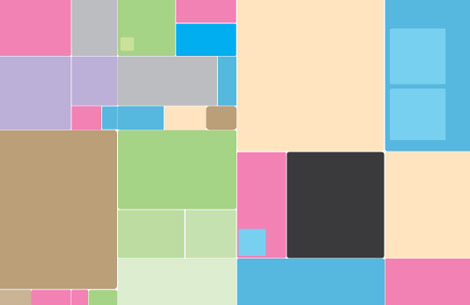
David McCandles is a London-based author, writer and designer who’s website is called Information Is Beautiful. I’ve never heard of an ‘independent visual and data journalist, but I have now, and think I like them. Tons of great information graphics and a weighty client-base to boot.
“My pet-hate is pie charts. Love pie. Hate pie-charts.”
www.informationisbeautiful.net
-----
Via It's Nice That
Personal comment:
Just a resource and a blog about well designed information design... project.
Friday, October 24. 2008
Postspectacular / Generative scene

There is an article about Postspectacular in the last Creative Review magazine. Karsten Schimdt and his colleagues car be labeled as "creative coders" or "generative designers" in the following of Lia, Dextro and all the Processing scene who's father would be John Maeda (design by numbers). On the other hand, you also find coders like former student Juerg Lehni, who's work goes through code, collaboration and design machines & tools.
Note: the generative scene is much older in the architectural creative environment than in the visual one. With grand-fathers like Peter Eisenman and Daniel Libeskind, fathers like Greg Lynn or Asymptote (paper-less studio) and thousands of contemporary childs. This scene is now moving into digital fabrication (Roche DSV & Sie, Gramazio Kohler, etc.)
See links below for the visual scene.
Related Links:
Wednesday, August 13. 2008
A Wikipedia Reader
by Mylinh Trieu Nguyen & David Horvitz
A diverse group of artists were asked to conduct a Wikipedia search, and then to continue onto other articles through linked words, creating a “string” of ideas. The final form is a reader containing these articles …
Tuesday, July 29. 2008
Faber Finds generative book covers
By Gavin on Creative Review 's blog
-
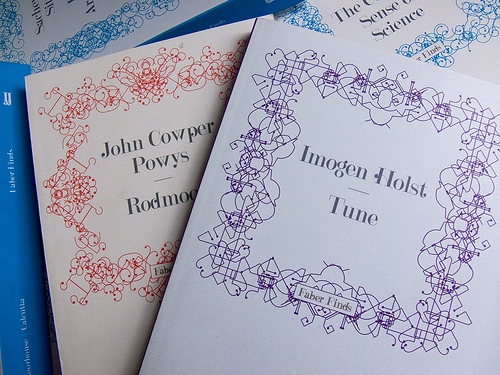
Faber Finds is a recently launched service offered by publisher Faber and Faber that utilises digital print technology and affordability to make out-of-print books available once more. Basically, a book is only printed when someone orders it - and, thanks to some clever generative programming by Universal Everything’s Karsten Schmidt (who was working for postspectacular.com at the time of commission), each cover printed promises to be totally unique. Various decorative elements designed by Marian Bantjes are arranged by the programme into a decorative border around the book’s title and author. The latter appear in a bespoke font, b-hmmnd, designed by Build’s Michael Place.

The process may sound relatively straightforward when distilled like this but Karsten Schmidt has talked to cr about the complexities of the programming – from getting to grips with the rules and nature of the design elements to creating a generative solution which would introduce variations at certain points of its design process, manage and even aesthetically judge them automatically. As promised in the current issue, here is Schmidt’s full technical breakdown of the processes involved:
A year ago Faber & Faber commissioned PostSpectacular to help with the design of a software system to generate complete & print ready book covers for their new imprint Faber Finds, an on-demand print service of out-of-print books. The challenge was more of a creative than a technical one, as the task given was to build a “design machine” which would be flexible enough to generate a very large (theoretically infinite) number of unique designs, one for each single book printed, within the agreed boundaries set by Faber’s art direction.
Faber also commissioned Canadian typographer Marian Bantjes to create four designs used as templates for the desired look & feel of the borders styles of each of the different genres offered by the imprint (Fiction, Non-fiction, Arts and Children’s). Each of her design routes then needed to be abstracted, decomposed into smaller elements & shapes, parametrized and generally reverse engineered conceptually.

Only once we understood all the rules and nature of the design elements used on all levels, we could start building a generative solution which would introduce variations at certain points of its design process, manage and judge them automatically. This initial part of the process included things like identifying the 5 levels of symmetry used in Marian’s sketches, experimenting with minimum and maximum border widths & densities, exploring individual symmetry limits per shape element, finding the right amounts of shape elements used per border quadrant, ensuring author names and titles (set in Michael C. Place’s beautiful B-HMMND font) are correctly word wrapped whilst not being obscured by the borders etc. In total we isolated over 35 of such rules and parameters…

Generative design systems often work on the premise of extrapolating a given design idea/art direction. Because our aim was to create such a system (rather than a single one-off design), it was important to find the extreme cases and boundaries of expressions possible and then shaping them. Finding appropriate values to these design parameters required a phase of constant experimentation and conversations with Faber’s design team - these collaboratively agreed boundary values then became the encoded art direction within the software.

Generating the borders was just one, if major, task of the final solution, though. Our custom software was developed in Processing (http://processing.org), Java and PHP and works as an internal webservice at Faber which receives new batch orders and then generates complete, print ready PDF files with all copy, branding, spine, ISBN, barcode and optional high-res JPG preview using the book details supplied. Generating a single cover only takes about 1 second, but due to its iterative and semi-random nature can sometime require hundreds of attempts until a “valid” design is created which is judged to be “on brand” by software itself.
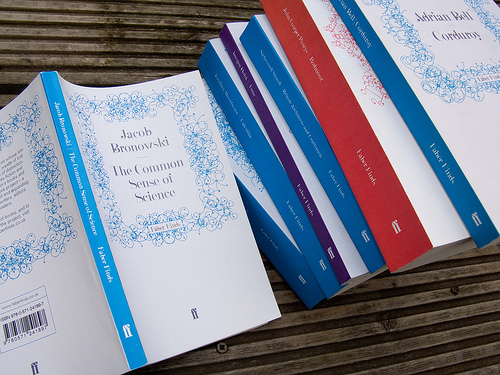
The project was art directed by Darren Wall at Faber and Faber.
To see Karsten Schmidt’s own blogpost about this project, visit postspectacular.com/process/20080711_faberfindslaunch
faber.co.uk/faberfinds
bantjes.com
wearebuild.com
Related Links:
Monday, July 21. 2008
Cloud, London Heathrow - Troika

Troika has been commissioned by Artwise Curators to create a signature piece at the entrance of the new British Airways luxury lounges in Heathrow Terminal 5. In response, we created ‘Cloud’, a five meter long digital sculpture whose surface is covered with 4638 flip-dots that can be individually addressed by a computer to animate the entire skin of the sculpture. Flip-dots were conventionally used in the 70s and 80s to create signs in train-stations and airports. We were fascinated by their materiality, by the way they physically flip from one side to the other. The sound they generate is also instantly reminiscent of travel, and we therefore decided to explore their aesthetic potential in ‘Cloud’.

By audibly flipping between black and silver, the flip-dots create mesmerising waves as they chase across the surface of ‘Cloud’. Reflecting its surrounding colours, the mechanical mass is transformed into an organic form that appears to come alive, shimmering and flirting with the onlookers that pass by from both above and below.
fabric | rblg
This blog is the survey website of fabric | ch - studio for architecture, interaction and research.
We curate and reblog articles, researches, writings, exhibitions and projects that we notice and find interesting during our everyday practice and readings.
Most articles concern the intertwined fields of architecture, territory, art, interaction design, thinking and science. From time to time, we also publish documentation about our own work and research, immersed among these related resources and inspirations.
This website is used by fabric | ch as archive, references and resources. It is shared with all those interested in the same topics as we are, in the hope that they will also find valuable references and content in it.
Quicksearch
Categories
Calendar
|
|
July '25 | |||||
| Mon | Tue | Wed | Thu | Fri | Sat | Sun |
| 1 | 2 | 3 | 4 | 5 | 6 | |
| 7 | 8 | 9 | 10 | 11 | 12 | 13 |
| 14 | 15 | 16 | 17 | 18 | 19 | 20 |
| 21 | 22 | 23 | 24 | 25 | 26 | 27 |
| 28 | 29 | 30 | 31 | |||
